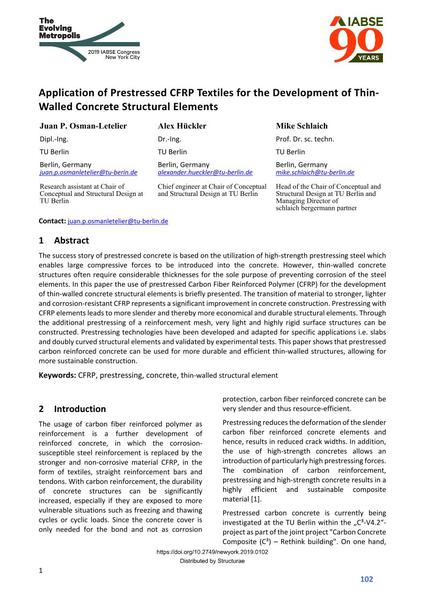Application of Prestressed CFRP Textiles for the Development of Thin-Walled Concrete Structural Elements

|
|
|||||||||||
Détails bibliographiques
| Auteur(s): |
Juan Pablo Osman Letelier
(TU Berlin)
Alex Hückler (TU Berlin) Mike Schlaich (TU Berlin) |
||||
|---|---|---|---|---|---|
| Médium: | papier de conférence | ||||
| Langue(s): | anglais | ||||
| Conférence: | IABSE Congress: The Evolving Metropolis, New York, NY, USA, 4-6 September 2019 | ||||
| Publié dans: | The Evolving Metropolis | ||||
|
|||||
| Page(s): | 102-109 | ||||
| Nombre total de pages (du PDF): | 8 | ||||
| DOI: | 10.2749/newyork.2019.0102 | ||||
| Abstrait: |
The success story of prestressed concrete is based on the utilization of high‐strength prestressing steel which enables large compressive forces to be introduced into the concrete. However, thin‐walled concrete structures often require considerable thicknesses for the sole purpose of preventing corrosion of the steel elements. In this paper the use of prestressed Carbon Fiber Reinforced Polymer (CFRP) for the development of thin‐walled concrete structural elements is briefly presented. The transition of material to stronger, lighter and corrosion‐resistant CFRP represents a significant improvement in concrete construction. Prestressing with CFRP elements leads to more slender and thereby more economical and durable structural elements. Through the additional prestressing of a reinforcement mesh, very light and highly rigid surface structures can be constructed. Prestressing technologies have been developed and adapted for specific applications i.e. slabs and doubly curved structural elements and validated by experimental tests. This paper shows that prestressed carbon reinforced concrete can be used for more durable and efficient thin‐walled structures, allowing for more sustainable construction. |
||||
| Mots-clé: |
béton
|
||||
